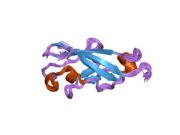PCDHA6
Protocadherin alpha-6 is a protein that in humans is encoded by the PCDHA6 gene.[3][4][5]
This gene is a member of the protocadherin alpha gene cluster, one of three related gene clusters tandemly linked on chromosome five that demonstrate an unusual genomic organization similar to that of B-cell and T-cell receptor gene clusters. The alpha gene cluster is composed of 15 cadherin superfamily genes related to the mouse CNR genes and consists of 13 highly similar and 2 more distantly related coding sequences. The tandem array of 15 N-terminal exons, or variable exons, are followed by downstream C-terminal exons, or constant exons, which are shared by all genes in the cluster. The large, uninterrupted N-terminal exons each encode six cadherin ectodomains while the C-terminal exons encode the cytoplasmic domain. These neural cadherin-like cell adhesion proteins are integral plasma membrane proteins that most likely play a critical role in the establishment and function of specific cell-cell connections in the brain. Alternative splicing has been observed and additional variants have been suggested but their full-length nature has yet to be determined.[5]
References
Further reading
- Yagi T, Takeichi M (2000). "Cadherin superfamily genes: functions, genomic organization, and neurologic diversity". Genes Dev. 14 (10): 1169–80. doi:10.1101/gad.14.10.1169. PMID 10817752.
- Nollet F, Kools P, van Roy F (2000). "Phylogenetic analysis of the cadherin superfamily allows identification of six major subfamilies besides several solitary members". J. Mol. Biol. 299 (3): 551–72. doi:10.1006/jmbi.2000.3777. PMID 10835267.
- Senzaki K, Ogawa M, Yagi T (2000). "Proteins of the CNR family are multiple receptors for Reelin". Cell. 99 (6): 635–47. doi:10.1016/S0092-8674(00)81552-4. PMID 10612399.
- Wu Q, Maniatis T (2000). "Large exons encoding multiple ectodomains are a characteristic feature of protocadherin genes". Proc. Natl. Acad. Sci. U.S.A. 97 (7): 3124–9. doi:10.1073/pnas.060027397. PMC 16203
 . PMID 10716726.
. PMID 10716726.
- Wu Q, Zhang T, Cheng JF, et al. (2001). "Comparative DNA Sequence Analysis of Mouse and Human Protocadherin Gene Clusters". Genome Res. 11 (3): 389–404. doi:10.1101/gr.167301. PMC 311048
 . PMID 11230163.
. PMID 11230163.
- Strausberg RL, Feingold EA, Grouse LH, et al. (2003). "Generation and initial analysis of more than 15,000 full-length human and mouse cDNA sequences". Proc. Natl. Acad. Sci. U.S.A. 99 (26): 16899–903. doi:10.1073/pnas.242603899. PMC 139241
 . PMID 12477932.
. PMID 12477932.
- Schmutz J, Martin J, Terry A, et al. (2004). "The DNA sequence and comparative analysis of human chromosome 5". Nature. 431 (7006): 268–74. doi:10.1038/nature02919. PMID 15372022.
- Gerhard DS, Wagner L, Feingold EA, et al. (2004). "The Status, Quality, and Expansion of the NIH Full-Length cDNA Project: The Mammalian Gene Collection (MGC)". Genome Res. 14 (10B): 2121–7. doi:10.1101/gr.2596504. PMC 528928
 . PMID 15489334.
. PMID 15489334.
PDB gallery |
|---|
|
| 1wuz: Structure of EC1 domain of CNR |
|
|


 . PMID 10716726.
. PMID 10716726. . PMID 11230163.
. PMID 11230163. . PMID 12477932.
. PMID 12477932. . PMID 15489334.
. PMID 15489334.